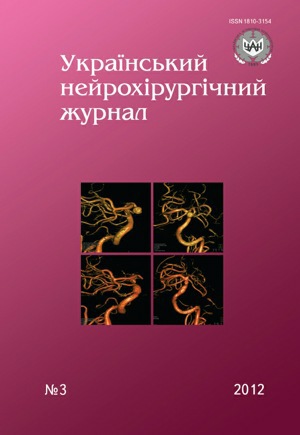Assessment of quality of neurosurgical care rendering in secondary prevention of cerebrovascular diseases in Ukraine
DOI:
https://doi.org/10.25305/unj.60850Keywords:
cerebrovascular disease, neurosurgical care, secondary preventionAbstract
Introduction. Effective measures at cerebrovascular disease (CVD) are primary and secondary measures for prevention of brain blood circulation disorders that are used within global (WHO) and national programs.
Materials and methods. Results of continuous research of treatment work in Ukrainian neurosurgical units in 2001–2010 years, data of WHO, indicators of neurosurgical and neurologic services in Ukraine and Russian Federation were analyzed.
Results and their discussion. In 2010 twice more patients with CVD have been treated than in 2001 (respectively 4837 and 8923). For this period surgical activity grew in 1.4 times (from 33.8 to 47.2%), the number of operations increased in 2.7 times — from 1637 — in 2001 to 4215 — in 2010, the postoperative lethality decreased from 17.2 to 12.3%.
Conclusions. Specialization of vascular units and centers — is one of the major factors, influencing on improvement of secondary prevention at patients after vascular attack. Level of providing of CVD secondary neurosurgical prevention is highest in Kiev, sufficient — in Dnepropetrovsk and Kharkov regions and nonsufficient — in other regions of the country.
References
1. The top 10 causes of death. [Internet]. [cited 2014 May]. Available at: http://www.who.int/mediacentre/factsheets/fs310/en/
2. Mathers C, Bernard C, Iburg K. Global Burden of Disease: Data sources, methods and results. [Internet]. Available at: http://www.who.int/healthinfo/bod/en/index.html, https://apps.who.int/infobase/Comparisons.aspx
3. Current statistics for stroke survival rates are. [Internet]. Available at: http://www.theuniversityhospital.com/stroke/stats.htm
4. Mayo NE, Wood-Dauphinee S, Ahmed S. Disablement following stroke. Disabil. Rehabil. 1999;21(5–6):258–268. [PubMed]
5. Mishchenko T S. Analiz sostoyaniya rasprostranennosti, zabolevayemosti i smertnosti ot tserebrovaskulyarnykh zabolevaniy v Ukraine. Sudinní zakhvoryuvannya golovnogo mozku. 2007;3:2–4. Russian.
6. Yavorskaya VA, Moskovko SP, Treshchinskaya MA. Povtornyy insult — ne prigovor [Repeated strokes - not a sentence]. [Internet]. Zdorovya Ukrayiny. Russian. Available at: http://www.health-ua.org/archives/health/1827.html
7. Mishchenko TS. Stan nevrolohichnoyi sluzhby v Ukrayini [State of neurological services in Ukraine]. [Internet]. Zdorovya Ukrayiny. Ukrainian. Available at: http://www.health-ua.org/article/health/1534.html
8. Sapon NA, Huk AP, Kirichenko VM, Chitaeva GE, Nikiforova AN. [Statistics data analysis on specialized neurosurgical care giving in cerebrovascular diseases in Ukraine]. Ukrainian Neurosurgical Journal. 2010;1:60–65. Ukrainian.
9. Kondakov YeN. Neyrokhirurgicheskaya sluzhba Rossiyskoy Federatsii v 2003 godu [Neurosurgical Service of the Russian Federation in 2003]. [Internet]. Russian. Available at: http://www.neuro.neva.ru/ru/Articles_2005_1/kondakov.shtml
10. Krylov VV, Gelfenbeyn MS, Nikulin AM. Opyt khirurgicheskogo lecheniya insultov v krupnom promyshlennom gorode [Experience of surgical treatment of stroke in a large industrial city]. In: Abstract Book of Conference «Vascular Diseases of the Brain and Spinal Cord»; 2000, Omsk, Russia. Omsk, 2000, p. 136. Russian.
11. Kozelkin AA, Kozelkina SA, Revenko AV. Sikorskaya MV. Sistema etapnoy pomoshchi bolnym s mozgovymi insultami [Internet]. Mezhdunarodnyy nevrologicheskiy zhurnal. 2006;(3). Russian. Available at: http://www.mif-ua.com/archive/article/2524
Downloads
Published
How to Cite
Issue
Section
License
Copyright (c) 2012 Nikolay Sapon, Andriy Huk, Vasyl Kirichenko, Galina Chitaeva, Anna Nikiforova, Tatiana Yovenko

This work is licensed under a Creative Commons Attribution 4.0 International License.
Ukrainian Neurosurgical Journal abides by the CREATIVE COMMONS copyright rights and permissions for open access journals.
Authors, who are published in this Journal, agree to the following conditions:
1. The authors reserve the right to authorship of the work and pass the first publication right of this work to the Journal under the terms of Creative Commons Attribution License, which allows others to freely distribute the published research with the obligatory reference to the authors of the original work and the first publication of the work in this Journal.
2. The authors have the right to conclude separate supplement agreements that relate to non-exclusive work distribution in the form of which it has been published by the Journal (for example, to upload the work to the online storage of the Journal or publish it as part of a monograph), provided that the reference to the first publication of the work in this Journal is included.









